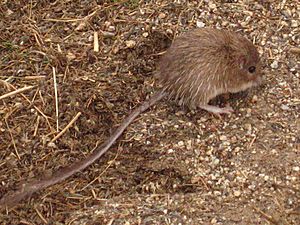San Diego pocket mouse facts for kids
Quick facts for kids San Diego pocket mouse |
|
|---|---|
 |
|
| In Riverside County, California, US | |
| Conservation status | |
| Scientific classification | |
| Genus: |
Chaetodipus
|
| Species: |
fallax
|
Meet the San Diego pocket mouse (Chaetodipus fallax). This small rodent is part of the Heteromyidae family. You can find these mice in the southern parts of Baja California. Their home stretches from near San Diego all the way into Mexico.
Contents
What Does the San Diego Pocket Mouse Look Like?
The San Diego pocket mouse is a medium-sized mouse. It has dark brown fur on its back and white fur on its belly. These mice are usually about 17 to 20 centimeters (7 to 8 inches) long. They weigh around 17 to 22 grams (about half an ounce).
Their body temperature stays warm and steady, just like humans. They have special teeth that are good for grinding tough food. Another mouse, C. californicus, looks similar and lives in the same areas.
Life Cycle and Reproduction
San Diego pocket mice often live alone. This makes it a bit tricky to study how they have babies. Many of them mate in the spring. However, some can have babies at other times of the year too.
They usually reproduce one to three times each year. More rain often means more babies are born. A mother mouse typically has 2 to 6 babies in one litter. Her pregnancy lasts about 24 to 26 days. Female mice are the main caregivers. They nurse their young and keep them safe inside their burrows.
How Long Do San Diego Pocket Mice Live?
In the wild, San Diego pocket mice usually live from four months to two years. Many mice die because other animals hunt them. This happens more often in spring. That's when mice are busy looking for food, having babies, and protecting their homes. In safe places like labs, without predators, some mice have lived up to six years!
How Do San Diego Pocket Mice Behave?
The San Diego pocket mouse is built for moving slowly on all four feet. When they need to go fast, they "gallop." They push off the ground with both feet at once. Their tail helps them keep their balance.
These mice look for food at night to avoid predators. They gather food in special pouches inside their cheeks. Then, they store this food in different rooms within their burrows. Burrows are their main home, especially in winter when they are less active. Their burrows have separate rooms. One room is for sleeping, and others are for storing food.
Sometimes, a mouse might squeak to warn others about danger. They have large eyes and ears. These help them sense what is happening around them.
Where Do San Diego Pocket Mice Live?
Male San Diego pocket mice usually roam over an area of about 3,500 square meters. Females tend to stay in a smaller area, about 2,500 square meters. They protect their home areas from other mice. But they will let potential mates in during breeding season.
Their typical home has rocks, sand, and small plants for cover. You might see plants like Yucca and desert scrub in these areas.
What Do San Diego Pocket Mice Eat?
San Diego pocket mice are mostly seed-eaters. They love to find and eat seeds. Their cheeks have fur-lined pouches. These are perfect for carrying lots of seeds!
These mice can live on seeds alone. They don't even need to drink extra water. They get all the water they need from their food. They also get water from their body's processes. When it's very hot, they eat seeds with more moisture. This helps them stay cool and not lose too much water. If seeds are hard to find, they might eat leaves, stems, or even insects.
Who Hunts the San Diego Pocket Mouse?
Many animals hunt the San Diego pocket mouse. These include foxes, coyotes, badgers, owls, and snakes. To stay safe, the mice have dark fur. This helps them blend in with their surroundings at night. Their varied hopping style also makes it hard for predators to catch them.
How Do San Diego Pocket Mice Help the Ecosystem?
San Diego pocket mice are important for their environment. When they dig their burrows, they help loosen the soil. This lets air get into the ground. When they collect seeds in their cheek pouches and store them, they also help spread plant seeds. This helps new plants grow in different places.
These mice can also carry ticks and fleas. They also compete with other rodents for food. Some rodents can live together. For example, mice that need more water will eat wetter seeds. This leaves drier seeds for mice that get their water by drinking.
Conservation Status
The San Diego pocket mouse is listed as a species of "least concern" by the IUCN Red List. This means they are not currently in danger.


